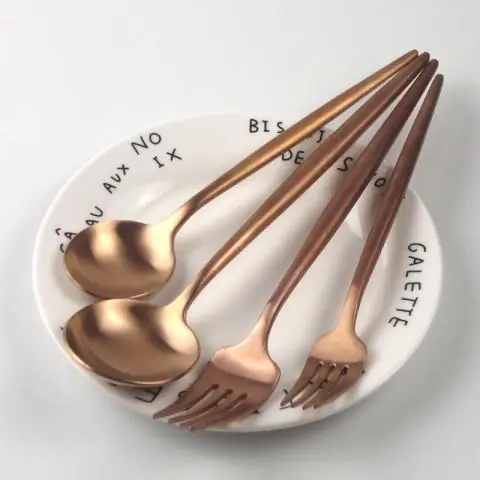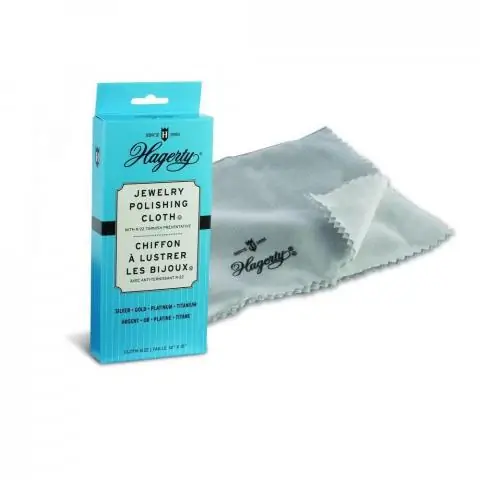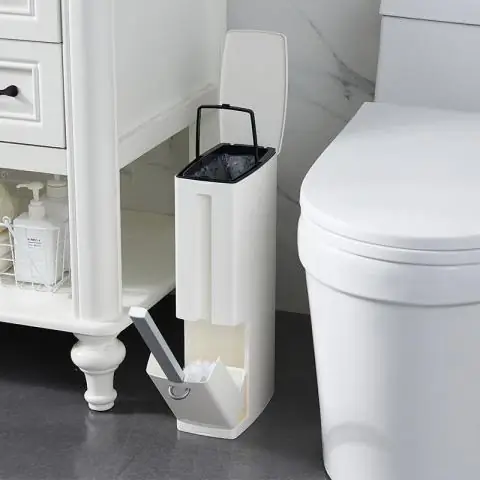
Table of contents:
- Author Bailey Albertson [email protected].
- Public 2023-12-17 12:53.
- Last modified 2025-01-23 12:41.
We clean cutlery from cupronickel

On the festive table you want beauty and gloss. And here, cupronickel cutlery comes to the rescue, pleasing the eye with a soft shine. However, housewives often have to tinker with them, since this metal quickly oxidizes and turns black. Therefore, it is important to master a few simple rules for caring for cupronickel products.
Content
- 1 Pros and cons of cupronickel
- 2 Where do black spots come from on cupronickel
-
3 How to clean cupronickel products
- 3.1 Cleaning cupronickel with soda or ammonia
- 3.2 Eggshell decoction for heavily browned products
-
3.3 How to get rid of darkening using food foil
3.3.1 Video - how to clean cupronickel devices using foil
- 3.4 Chalk polishing
- 3.5 How to clean gilded appliances
- 4 What to do to avoid black deposits on cutlery
Pros and cons of cupronickel
Cupronickel is an alloy of copper and nickel, sometimes with an admixture of other components, for example, iron and manganese. In color, it is similar to the third most important noble metal - silver. For this feature, he received another name - "the silver of the poor."
It is believed that for the first time an alloy similar to silver appeared in China long before the new era. The alloy was called pakfong and was used for minting coins, creating jewelry and other things. Then the Pakfong came to Europe, where it gained extraordinary popularity. It got to the point of ridiculousness: Pakfong items were more expensive than silver items. After all, the Europeans did not know that the light, beautiful metal was similar to silver only outwardly, and there was not a grain of precious metal in its composition - only copper and nickel, with minor impurities of other metals.
The European birth of the alloy took place in Germany, where it was dubbed Neisilber - “new silver”. But then there was a war with Napoleon, during which all the documentation on a promising alloy ended up in France. After some time, two Frenchmen, Mayo and Shore, took up the alloy of copper and nickel. Without the slightest doubt, they named the successful metal with a new name, in which they combined parts of their names - major.
But the Germans reared on their hind legs, protesting against such impudence. Unable to return the name given to the metal, they changed the French: instead of the major, the metal began to be called cupronickel. According to Christian tradition, Melchior was the name of one of the wise wise men who brought gifts to the newborn Jesus in Bethlehem.
Since German terminology has always dominated in metallurgy, the Pakfong Major became cupronickel.
Great Soviet Encyclopedia
Alloy advantages:
-
affordability: budget cupronickel is an excellent alternative to table silver, not inferior to either aesthetic or mechanical properties;

Cupronickel cutlery Budget nickel silver is an excellent alternative to table silver, which is not inferior either in aesthetic or mechanical properties
- low thermal conductivity: copper-nickel alloy heats up more slowly than silver, and you can safely dip a cupronickel spoon in hot tea without fear of getting burned;
- cupronickel is not afraid of rust;
- copper-nickel alloy is a fairly strong material and does not deform even with significant mechanical stress;
- durability: having once spent on beautiful cupronickel cutlery, you can be sure that they will serve you for a long time.
Cons of cupronickel cutlery:
- quickly lose their original shine and are subject to the formation of black spots;
- require constant care.
Where do black spots come from on cupronickel
Cupronickel is 50% copper - an easily oxidized metal. Despite the fact that the alloy also includes nickel, manganese and iron, the oxidation process remains unchanged, since these components practically do not affect it. As a result of oxidation, brownish spots appear on the devices, which eventually darken and acquire a bluish-black color.
Darkening most often appears due to non-compliance with storage conditions or improper care. It is not recommended to wash copper-nickel appliances in the dishwasher. Metal does not tolerate contact with chlorine or abrasive cleaning agents. Chlorine cleaning products cause an oxidation reaction and abrasives will scratch the finish.
How to clean cupronickel products
For regular care of cutlery from this alloy, use:
- soda;
- ammonia;
- eggshells;
- foil;
- a piece of chalk;
- toothpaste.
Cleaning cupronickel with soda or ammonia
For the simplest cleaning method you will need:
- 50 g of soda or 50 ml of ammonia;
- 1 liter of warm water.
Operating procedure:
-
Dissolve baking soda in warm water.

Soda solution in water Baking soda solution perfectly cleans dirt from cupronickel products
-
Wash appliances in a soda solution.

Clean spoons and forks on a napkin Dilute baking soda with warm water and wash cutlery in the solution.
-
Rinse thoroughly with cold water.

Cutlery is washed with running water After cleaning with soda, rinse the cutlery with cold water
- Wipe clean appliances dry.
You can also use ammonia instead of soda. Both of these products are good for cleaning minor dirt from spoons, forks and knives. The dull cupronickel, washed in this way, will acquire a soft sheen.
Eggshell decoction for heavily darkened products
The method is effective even for the most stubborn stains. You will need:
- the shell of two chicken eggs;
- 1 tbsp. l. table salt;
- 1 liter of boiled water.
Cleaning procedure:
- Pour water into a flat, shallow dish and set on fire.
-
Bring the water to a boil, add the shell, previously ground into powder, and salt to it.

Egg shell powder Add the shells of two raw chicken eggs, previously crushed into powder, to the water
-
Dip the cutlery in hot water and boil for two minutes.

Cleaning cutlery by boiling We boil the devices in a solution of crushed eggshells and table salt
- Take out the appliances, rinse and dry with a soft cloth.
How to get rid of darkening with food foil
For this cleaning method you will need:
- food foil;
- 3 tbsp. l. table salt;
- about 1 liter of water.
Operating procedure:
- Place food foil on the bottom of a saucepan and place cutlery on top of it.
-
Fill the container with water so that it completely covers the products, add salt.

Cupronickel devices on foil Food foil will help cupronickel cutlery to shine with its original shine
- Place a saucepan with utensils on fire and bring to a boil. Simmer for about three minutes.
As a result of a chemical reaction that occurs during boiling, food foil darkens and cutlery brightens. If there are strong darkening on cupronickel, repeat the procedure again.
Video - how to clean cupronickel devices with foil
Chalk polishing
The most ordinary chalk will help to cope with small dirt and polish cupronickel products to a shine:
-
Grind it into powder.

a piece of chalk Powdered chalk will polish cupronickel devices to a shine
-
Add a little water to make a viscous gruel.

Viscous gruel from chalk in a bowl A little water is added to the chalk powder until a viscous slurry is obtained
- Apply the mixture to a soft, lint-free cloth and buff the utensils.
If you don't have chalk on hand, use a non-abrasive toothpaste that contains silicon oxide: apply it to a moistened cotton pad and wipe the product.

Apply toothpaste to a cotton pad and wipe down the appliances
How to clean gilded appliances
For chic gold-plated appliances, there are some simple ways to remove dirt:
- Wipe the gilding with a piece of cotton wool dipped in wine vinegar or turpentine.
- Rub cupronickel cutlery with gilded egg white applied to a flannel cloth.

Gilded appliances are cleaned with wine vinegar, turpentine or egg white
What to do to avoid black deposits on cutlery
Use a few simple rules so that cupronickel cutlery always has a flawless appearance:
- store products in zip bags: a convenient lock will completely protect the contents from dust and moisture;
- also use tight-fitting wooden boxes with a piece of chalk inside for storing devices: it will protect the devices from oxidation;
- always wipe dry spoons, forks and knives from cupronickel;
- Wipe the garments regularly with a coarse woolen cloth, soft flannel cloth, or a silver-cleaning cloth.
The described methods of cleaning cupronickel are effective and not time consuming. Each housewife will be able to choose the most suitable one for herself and always keep her cutlery in perfect condition.
Recommended:
How To Clean Silver At Home From Blackness Quickly And Efficiently, Than To Properly Clean Silver Jewelry + Photos And Videos

How to quickly clean silver from blackness at home. Effective cleanser recipes. Methods for cleaning products with gilding and stones
How To Clean Gold At Home Quickly And Efficiently, How To Clean Gold Jewelry To Make It Shine + Photos And Videos

Methods for cleaning gold at home. How to quickly and effectively clean and remove dirt from different types of gold jewelry
How To Clean White Shoes At Home Made Of Natural, Artificial Leather And Other Materials + Photos And Videos

Features of cleaning white shoes. How to clean shoes made from natural or artificial materials. The subtleties of caring for sports white shoes, practical advice
How To Clean The Toilet At Home, How To Clean The Cistern And Lid, And Also Wash The Brush

Folk and professional remedies to clean the toilet, practical advice and prevention of various contaminants
How To Clean Gilded Silver And Other Gilding At Home + Photos And Videos

How to clean gilded silverware at home. Proven Cleaning Methods, Helpful Tips for Caring for Gold Plating
